
BIOREADER® 7000 -V
For non-fluoro applications in 384 well to 6 well plates and Petri dishes.
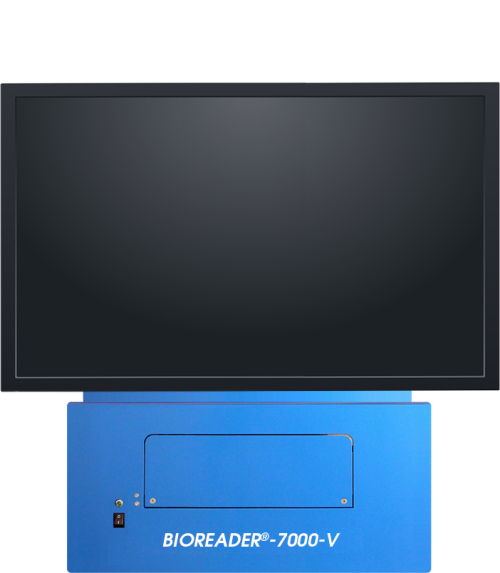
Using the BIOREADER® 7000 -V you may analyze enzymatic Elispot in 96 well plates as well as other applications liek Plaque/FOCI in different multiwell plates.
With common fixed focal length objectives also other plate types in full field-of-view are possible: 6- to 1536 well plates, Terasaki plates, upt to 100 mm Petri dishes and cell culture bottles (like T-Flask).
And they provide a resolution of: 100 - 2000 µm for FOCI, 100 - 5000 µm for Plaques or 50 - 2000 µm for cell clones.
The automatic objective changer and camera focusing are software-controlled.
This Bioreader® is able to quantify visible stain. For instant CV, DAB (3,3′-Diaminobenzidine), Substrates TMB,PCIP/NBT, AEC
Model variants:
Basic: 12 MPixel camera, 1 fixed focal length objective, for example for 96 well plates (with high resolution), as well as 48 and 24 well plates (with lower resolution).
Alpha: 5 MPixel camera, 2-times objective changer, for example for 96 and 24well plates with high resolution (with high resolution).
Beta: 5 MPixel camera, 3-times objective changer, for example for 96, 24 and 6 well plates with high resolution (with high resolution).
Gamma: 5 MPixel camera, 4-times objective changer, for example for 96, 24 6 well plates and 50 mm cell culture plates (with high resolution).
Tests of antiviral substances
This Bioreader® and EazyReader® support testing and development of antiviral substances.
Example#1: The automatic analyses of Plaque reductions assay.
This assay applies diluted doses of a -possibly- antiviral drug into multiwell plates. The Bioreader automatically observes its capability to suppress the formation of plaques (-holes-) in the bacterial lawn.
The ‘Plaque reductions neutralization test’ (PRNT) is a variation of this test. It is an attempt to find an antibody that neutralizes a specific virus. This is a very valuable tool in antiviral vaccine research.
Examplel#2: The automatic evaluation of the Yield reduction assay
In several steps of operation cells are infected in presence of variable doses of a possibly antiviral drug substance.
Thereafter the virus titer is determined in the liquid by use of the plaque or TCID50 assay with of the Bioreader®.
The titer is calculated as the quotient of the positive cells/all cells, taking in account the virus dilution factor and the volume of the inoculum.
- Patented dual telecentric illumination.
- Front loader with automatic door.
- Lens changer for high definition lenses with fix focal length.
- Automatic focus, illumination and lens changer are measure protocol controlled (GxP locked).
- High resolution camera with 5 MPixel (up to 42 MPixel available).
- Incl. computer and monitor.
- Excel/Word/PowerPoint and LIMS export capabilities.
- Interactive content specific video training program.
- Suitable for research purpose.
- For ‘phantom spot suppression’, better spot separation and cytokine quantification.
- Optional automation with plate 'feeding system'.
- DQ/IQ/OQ/PQ documentation possible.
- 12 months warranty.
- EC declaration of conformity and EMC certificate.

- Innovative Bioreader® and EazyReader® software combines ‘easy of use’ and versatility and flexibility.
- Scan, analyze and overlay live time.
- Creates up to 7 images for each well simultaneously during the scan.
- ‘Profiling’ app helps to create user independent measure protocols for Elispot beginners and references for experts.
- Verified in collaborative studies.
- Export options and reports with all scalable images and results even in one file.
- Customer specific export and report templates.
- Video clips and content specific help files.
- Qualified installation and training with each instrument.
- On-site or internet remote services and support.
- ‘Classified’ measure protocols ‘history’ tracking and comparison tools.
- User specific plates, Studies/projects, plate layouts/designs and measure protocols prevent from mix-up.
- More accurate ‘cytokine quantification’ based on the patented ‘photometric’ dual illumination system.
- Optional software features:
- 'Routine’ software package: Ooptimized applications for commonly used operations, only presents the icons you require for the specific job, quickly read a plate and quickly review, Q.C. and release the results.
- 21 CFR part 11 based software module available.
Dimension
Weight
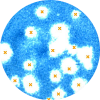
Plaque assay: very bright plaques in 24 well plate
Cells were infected and covered with an overlay. Cells stained with CV survive. Unstained cells were killed by the virus.

Foci assay: total well view
"The focus forming assay (FFA) is a variation of the plaque assay, but instead of relying on cell lysis in order to detect plaque formation, the FFA employs immunostaining techniques using fluorescently labeled antibodies specific for a viral antigen to detect infected host cells and infectious virus particles before an actual plaque is formed."
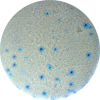
Elispot in 384 well microfilter plates
Small volume, higher throughput.

Elispot - Enzymatic dual color
Blue and red Elispot substrate (mixed color violet)
Dual cytokine secretion.

Elispot - Enzymatic single color
Blue, red, green or silver substrat Elispot.
Detection of antibodies. Enzyme-conjugated and precipitating substrate.
"The enzyme-linked immune absorbent spot (ELISpot) is a type of assay that focuses on quantitatively measuring the frequency of cytokine secretion for a single cell."
[https://en.wikipedia.org/wiki/ELISpot]
Why Elispot?
The cytokine Elispot assay is designed to enumerate cytokine secreting cells in single cell suspensions of lymphoid tissue, CNS tissue, bone marrow or preparations of peripheral blood mononuclear cells (PBMC).
The assay has the advantage of detecting only activated/memory T cells and the cytokine release can be detected at the single cell level, allowing direct determination of T cell frequencies.
The ELISPOT assay is an effective tool to enumerate antigen-specific T cells in the circulation of immunized humans and animals at much lower frequencies than possible with other currently available methods.
The ELISPOT assay has proven to be a sensitive and unique system to follow disease progression in human individuals or animals. Several studies have indicated that alterations in the frequency of cytokine pc in different compartments of the body adequately reflect changes in immune function.
The ELISPOT assay may be used to determine effects of drugs, chemicals or other compounds on cytokine secretion in vitro, thereby providing data on their putative modulatory effects on immune function in vivo
The ELISPOT assay is currently being used increasingly for the quantitative assessment of peptide reactive T lymphocytes from PBMC in infectious disease (3, 9) or in the course of vaccination trials aimed at the induction of tumor-specific T cells in patients with cancer.
Elispot may be used for Diagnosis of genetic defects,Allergic diseases,Autoimmune diseases,Transplantation,Cancer research,Acute inflammation,Acute infectious diseases and septic shock.

Unstained cells
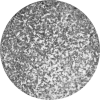
AEC graylevels
"Typically, type 1 alveolar cells comprise the major gas exchange surface of the alveolus and are integral to the maintenance of the permeability barrier function of the alveolar membrane. Type 2 pneumocytesare the progenitors of type 1 cells and are responsible for surfactant production and homeostasis."
[https://www.sciencedirect.com/topics/medicine-and-dentistry/alveolar-type-i-cells]
The alveolar epithelium is a major target in toxic exposures of the lung because of its structural delicacy and proximity to inhaled toxicants. Type II epithelial cells are important in maintaining the integrity of alveolar epithelium and normal lung function.

MCMV (Mouse Cytomegalovirus) unstained

HCMV (Human cytomegalovirus): unstained
"The glycoprotein gO (UL74) of human cytomegalovirus (HCMV) forms a complex with gH/gL. Virus mutants with a deletion of gO show a defect in secondary envelopment with the consequence that virus spread is restricted to a cell-associated pathway."
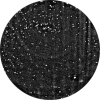
NK92 cells natural killer cells (human cell line) same samples microwell plate.
"Natural killer cells, or NK cells, are a type of cytotoxic lymphocyte critical to the innate immune system. Typically, immune cells detect major histocompatibility complex (MHC) presented on infected cell surfaces, triggering cytokine release, causing lysis or apoptosis."
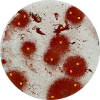
Foci assay: Very large Foci
"The focus forming assay (FFA) is a variation of the plaque assay, but instead of relying on cell lysis in order to detect plaque formation, the FFA employs immunostaining techniques using fluorescently labeled antibodies specific for a viral antigen to detect infected host cells and infectious virus particles before an actual plaque is formed."

Plaque assay extremely large spots
"The TCID50 (Median Tissue Culture Infectious Dose) is one of the methods used when verifying viral titer. TCID50 signifies the concentration at which 50% of the cells are infected when a test tube or well plate upon which cells have been cultured is inoculated with a diluted solution of viral fluid."

TCID50 viral assay
Cells were infected and covered with an overlay. Cells stained with CV survive. Unstained cells were killed by the virus.

CV Plaque assay.Example with large and fuzzy plaques
Cells were infected and covered with an overlay. Cells stained with CV survive. Unstained cells were killed by the virus.
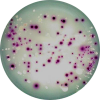
Various media/strain combinations on petridishes

Various colonies in 6 well plates and on 35 mm - 100 mm petridishes

Organoids
"An organoid is a miniaturized and simplified version of an organ produced in vitro in three dimensions that shows realistic micro-anatomy. The technique for growing organoids has rapidly improved since the early 2010s."

Neutralization assay
"The plaque reduction neutralization test is used to quantify the titer of neutralizing antibodies for a virus. The serum sample or solution of antibodies to be tested is diluted and mixed with a viral suspension."
[https://en.wikipedia.org/wiki/Plaque_reduction_neutralization_test]

Antibiotic potency USP/PhEur/DIN/BP Petrishes
The antibiotic potency assay measures the effectiveness of an antibiotic by the degree of growth inhibition on susceptible strains of microorganisms at different concentrations.

AEC color
"Typically, type 1 alveolar cells comprise the major gas exchange surface of the alveolus and are integral to the maintenance of the permeability barrier function of the alveolar membrane. Type 2 pneumocytesare the progenitors of type 1 cells and are responsible for surfactant production and homeostasis."
[https://www.sciencedirect.com/topics/medicine-and-dentistry/alveolar-type-i-cells]
The alveolar epithelium is a major target in toxic exposures of the lung because of its structural delicacy and proximity to inhaled toxicants. Type II epithelial cells are important in maintaining the integrity of alveolar epithelium and normal lung function.
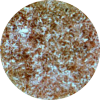
Alveolar epithelial cells (AEC)
"Typically, type 1 alveolar cells comprise the major gas exchange surface of the alveolus and are integral to the maintenance of the permeability barrier function of the alveolar membrane. Type 2 pneumocytesare the progenitors of type 1 cells and are responsible for surfactant production and homeostasis."
[https://www.sciencedirect.com/topics/medicine-and-dentistry/alveolar-type-i-cells]
The alveolar epithelium is a major target in toxic exposures of the lung because of its structural delicacy and proximity to inhaled toxicants. Type II epithelial cells are important in maintaining the integrity of alveolar epithelium and normal lung function.




